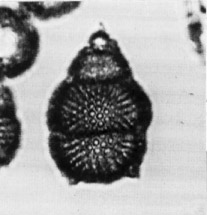 Cyrtocapsella
cornuta Haeckel
Cyrtocapsella
cornuta Haeckel Cyrtocapsella
cornuta Haeckel
Cyrtocapsella
cornuta HaeckelCyrtocapsa (Cyrtocapsella) cornuta Haeckel, 1887, p.1513, pl.78, fig.9
Cyrtocapsella cornuta Haeckel, Sanfilippo and Riedel, 1970, p.453, pl.1, figs.19-20 (with synonymy)
Four-segmented, pyriform skeleton. Cephalis spherical, poreless or with a few small pores, in most specimens with a short apical horn. Collar stricture pronounced. Thorax small, inflated-conical, separated from the much wider third segment by a very pronounced change in contour. Third segment truncate-hemispherical and fourth segment inverted-hemispherical with practically no external stricture between them. Mouth strongly constricted, about twice as wide as a pore. Pores subcircular to circular, not arranged in a regular pattern (Sanfilippo and Riedel, 1970).
Based on 30 specimens. Total length (excluding horn) 145-205 mm (usually 165-190 mm). Length of second segment 30-55 mm (usually about 45 mm), of third segment 45-70 mm (usually 50-60 mm), of fourth segment 50-80 mm. Maximum breadth 125 (rarely 115)-145 mm (Sanfilippo and Riedel, 1970).
A large species with generally pyriform outline, the cephalis and thorax separated from the two subsequent segments by a pronounced change in contour (at least internally). Post-lumbar stricture scarcely expressed externally (Riedel and Sanfilippo, 1978a).
See also discussion of Cyrtocapsella tetrapera.
The pyriform shell of four robust segments has an abrupt change in contour between the second and third segments, which is less pronounced externally than internally in very thick-walled specimens. Following the fourth, inverted-hemispherical segment with very restricted mouth, some specimens have a delicate, cap-like, inverted-conical closing fifth segment (Sanfilippo et al., 1985).
Cyrtocapsella cornuta occurs in substantial numbers in assemblages of late early to middle Miocene age from low and middle latitudes of all oceans, including the Mediterranean region. Its morphotypic first appearance lies within the Cyrtocapsella tetrapera Zone, and it becomes extinct within the Diartus petterssoni Zone.
This species probably developed from C. tetrapera, which accompanies C. cornuta throughout its stratigraphic range.
Additional illustrations can be found in Sanfilippo et al., 1973, pl.5, figs.1-2; Holdsworth, 1975, pl.2, figs.1-3, 5-8, 10.